Background
The Indoor Environment Quality (IEQ) of a building has significant influence on its acoustics perception. “IEQ is the totality of the acoustic characteristics of a building interior that impacts the aural perceptions of the occupants” (Paevere & Brown, 2008). This paper focuses on the positive and negative aspects of acoustics in 30 The Bond Building.
Methodology
The methodology of this acoustic evaluation is based on interviews and the author’s observation. The building services manager of 30 The Bond Building was the first respondent to be interviewed in order to get his view of the acoustic environment of the building. In addition, a second nominated interviewee was interviewed with an aim of establishing the users’ and workers opinion of the same.
External noise
As shown in figure 1 below, 30 The Bond Building experiences external noises from two sources which are; traffic and self generated noises. Despite having insignificant impact on the building, the main source of the external noise is considered to be from the traffic (fig. 1). This is according to the building services manager, Bradford Kerr.
Considering the people living in houses and units in the surrounding area, the building is considered as a source of noise. Furthermore, Bradford Kerr asserts that noise generated externally from the ‘cooling tower fans’ (fig. 1) can be heard from within the building.
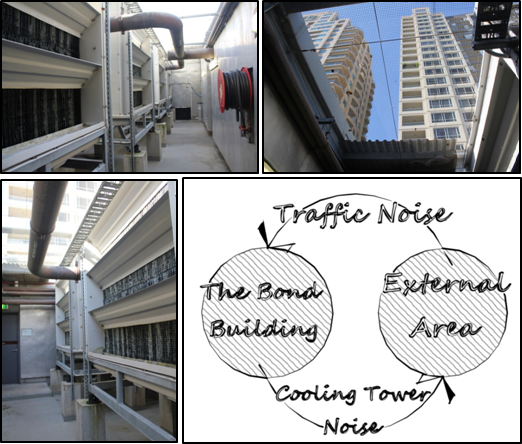
Internal noise
Internal noise in 30 The Bond Building is categorised by sources generated from public and private areas. The public areas (cafes, atrium and building entrance) are affected by noise generated from three main sources. The first source of noise is the large fans (figure 2) located in the atrium roof that aid in ventilating the area. According to the second interviewee (worker), these fans produce very disturbing level of noise especially during break time when they assemble in the public areas. However, many people remain unaffected by the noise generated from the fans since they consider it a low level disturbance. An evaluation of the noise generated from these fans indicated that people were affected most depending on the floor that they existed in relation to the location of fans. Hence, people in the higher levels were the most affected as compared to those in the lower levels. Therefore, in order to have the best noise evaluation of the building, various circumstances affecting different users should be put to consideration.
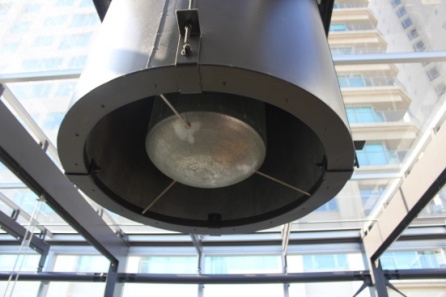
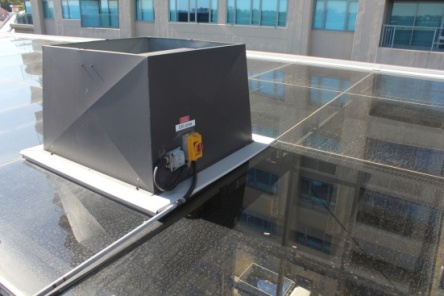
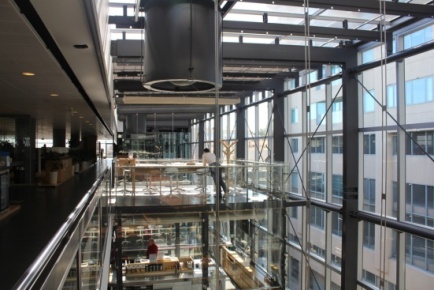
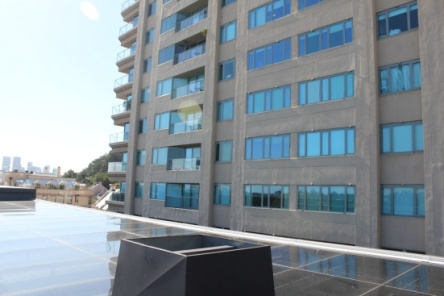
The power and diesel generators (fig. 3 and 4) located in the basement level accounts for the second source of noise within the public areas of the building. Firstly, the power generator as sown in figure 3 is operated on a daily basis in normal situations. According to the building services manager, this noise affects people using the public areas in the ground floor and basement parking more than people located in the higher levels of the building. Contrary to the effect of the cooling fans in the atrium, people in the lower levels are much more affected by the power generator than those in the higher levels of the building.
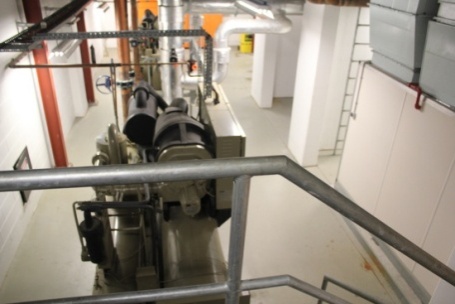
Secondly, the diesel generator as shown in figure 4 is operated during emergency situations such as power blackouts. According to Bradford Kerr the diesel generator produces the loudest noise that negatively affects the whole building when it is in operation. As a result, the diesel generator negatively affects all people in all the floors unlike the other sources mention which have a localised effect.

The Billabond Children’s Care Centre accounts for the third source of internal noise within the public areas of the building. This centre provides service for workers who bring their pre-school children for babysitting. Bradford Kerr asserts that, occasionally, children tend to play and make noise when they are with their parents in the Atrium. However, despite being considered as a source of noise, he states that it is usually insignificant and does not affect the commercial business of the building.
The private spaces (offices) in 30 The Bond Building, are generally very quiet as compared to the public spaces. Although some people may think that these quiet places are more comfortable, many of the workers and people, occupying the offices in this building completely differ with them. According to an interviewee, people working in the private places of 30 The Bond building consider the quietness as a problem which makes them feel uncomfortable As a result they use the positive type of noise called “White Noise”. “In the absence of ducts and air handling systems, an electronic sound masking system is used to provide background noise in 30 The Bond Building” (St. Clair, 2008). In addition, Bradford Kerr describes “White Noise” as a non-descriptive noise that supplies a background sound. When people are subjected to audible sensory deprivation they feel very uncomfortable. To counter this, a slight background hiss is made to replicate a modern city environment and thus alleviate this level of discomfort. The White Noise is generated individually through different ways. While some workers use especial devices known White Noise sound machine, others like to use other devices such as mp3 players and especial software in their computers to generate that background sound. While some interviewees state that they like the natural sound, for example, ocean waves and rainfall sounds, others prefer soft music to help them feel more comfortable in their private spaces.
Conclusion and recommendations
In conclusion, the study identifies both negative and positive aspects of acoustics in 30 The Bond Building. The negative aspects include the internal and external noises that affect public and private areas while the positive aspects include the “White Noise” providing positive effect on people working or visiting the private areas. According to the author’s observations in relation to discussions conducted with 30 The Bond Building staff, the private areas acoustic environment was satisfactory. However, the public areas are not acoustically satisfactory and the following recommendations to minimise the effect of related noise are suggested:
- The power and diesel generators should be enclosed using sound absorbent partitioning materials.
- The atrium fans should be replaced with more efficient and quiet fans.
The Acoustic environment in 30 The Bond Building are summarised in table 1 as shown below.
Table 1: The positive and negative sounds in 30 The Bond
References
Paevere, P., Brown, S. 2008, Indoor Environment & Productivity in Commercial Buildings. Web.
St. Clair, P. 2008, Human Health, Comfort & Productivity in Commercial Office Buildings – An Evaluation of 30 The Bond & Council House 2. Web.